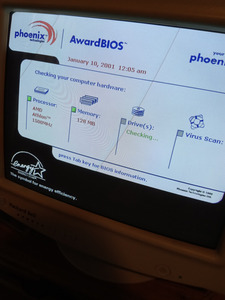First post, by Itisnot1984
Hey! My first post! I've been into computing since I was a kid. I've never really been into collecting or using old PC parts as a hobby until recently. I was nearly killed by covid a couple years ago, and about a month prior to getting to sick I had bought an old packard bell a950 with the monitor, keyboard and mouse at a yard sale for only $15. I'm disabled now, so I decided to try restoring it as something to do. It was a lot of fun, but I realize there's a lot of old stuff I'd like to have. Problem is - its expensive as hell! I decided to build a faster and more capable PC so that I can buy old parts in bulk AND test them out. I figure this will allow me to accumulate some cool stuff on the cheap and even sell some things to recoop my costs.
https://drive.google.com/file/d/1q3xX1gFHCu3d … ?usp=drive_link
I found a Biostar M7VKB super cheap because it wasn't listed properly. I figured I could drop in a later socket A cpu and have a decently fast system for testing old parts. When I received the board and began to properly look into it, I noticed it doesn't have the header to allow for jumpers that set the FSB. It is a KT133 chipset, so I figured maybe they dropped the header after it was figured out that 133 didn'ty work well on this chipset. Although the header wasn't there, the solder pads for it were still present, and there was some swollen caps on the board as well. I replaced the caps and then bridged the appropriate pads with solder. The board wouldn't boot at all. I removed the solder bridges, and it booted again. In hind sight, I looked at photos of an earlier revision and found quite a few components were missing from my board. I suppose it will never be possible to enable 133 on the board I have. I did find an option in the bios to adjust the FSB, but it doesn't include 133 as an option. I'm curious if it can be done or not. If not, thats fine. I purchased an athlon xp with a 15x multiplier, so I'll at least get 1.5ghz at a fsb of 100mhz. I also purchased an ebay job lot of around 30 expansion cards. Since I intend to test parts in bulk like this, speed was a consideration. I mean think about all the time I'll spend waiting for reboots just to get through this one box of parts. I know there are 16.5x multipliers, but I found those cpu's to be pretty expensive. If anyone knows how to make things faster, please, I would like to know.
https://drive.google.com/file/d/1qRqk3PHWstaT … ?usp=drive_link
https://drive.google.com/file/d/1qNFvlzaE5M8Q … ?usp=drive_link (JCLK1 is the missing header)
My knowledge on these things is limited. Sure I was tinkering with computers as far back as 25 years ago, but I've only recently become interested in retro computing as a hobby. As far as I can tell these old parts are expensive right now. My guess is in 10 years, it will be nearly impossible to get parts from way back. It feels like I've got a lot of catching up to do.
